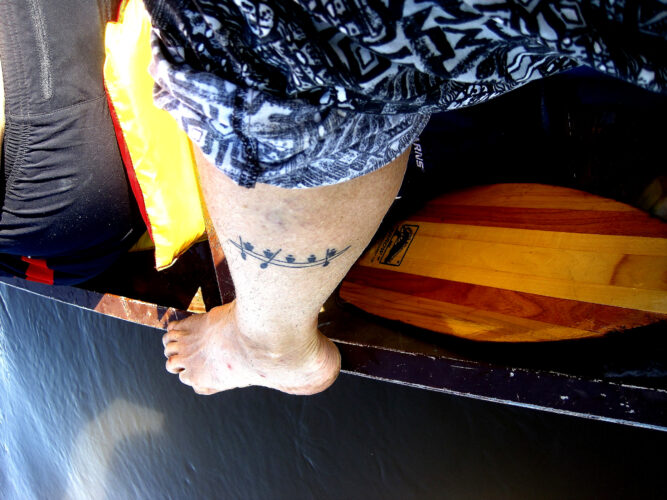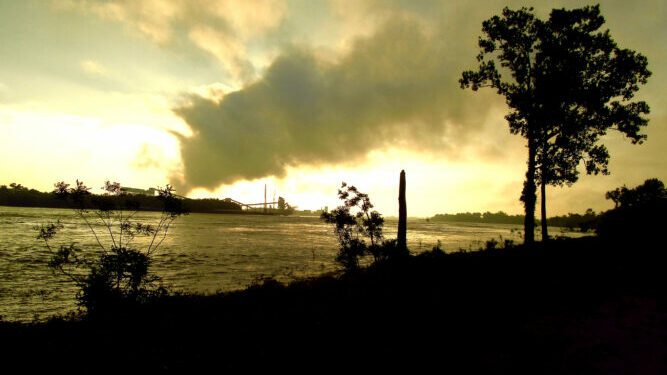Chemical alley on the lower Mississippi River in Louisiana has the look of a dystopian world in this atmospheric photo, taken at dawn. The heavy concentration of chemical industries between Baton Rouge and New Orleans adds to the river’s torrent of agricultural and other effluents, making this one of the world’s most heavily-polluted waterways. тАФ Photo by Debbie Lenox-White
Episode Five тАФ Greenville to The Gulf

Before we begin paddling, we must mention that Memphis, Tennessee, and the territory from there to Greenville is the birthplace of blues music. With themes of hard times, personal loss, and the unfairness of life, blues originated among slaves of the old south on the eve of the Civil War. Historians tell us other 100% American music: jazz, ragtime, and rock-and-roll, trace at least some of their roots to the blues.
It was steamboats on the Mississippi river that spread the blues, and jazz, to towns from Minnesota to Louisiana. In fact, it was aboard one of those steamers that IowaтАЩs own Bix Beiderbecke first met Louis Armstrong while Satchmo was playing with the on-board band. It was 1920, and that encounter changed the direction of the 18-year-old Davenport-born BeiderbeckeтАЩs life. He would become the first white jazz soloist in America, giving white audiences тАЬpermissionтАЭ to enjoy what many previously considered тАЬwicked African music.тАЭ
Now we take up a topic not yet discussed in these articles: the pollution of the Mississippi River. WeтАЩve long known that run-off, from farms, feedlots and confined animal operations, is a major contributor to the тАЬdead zoneтАЭ in the Gulf of Mexico. But farmers alone are not to blame for the poor water quality of the river. Wastewater treatment plants, fertilizer and pesticide run-off from golf courses and lawns, barges and tugboats, and industries that continue to use the river as a sewer all add to the filth.
In Anne Sherve-OseтАЩs book, тАЬMississippi Misadventures,тАЭ she writes, тАЬIn the early years, we could easily swim across the river. The water was crystal clear, and swimming a pleasure experienced many times a day. The further south we got, however, the worse the water got. The deteriorating water quality made us decide we wouldnтАЩt paddle any further than Iowa. No one wanted to luxuriate in oily, sewage-laden, brown, scummy water at the end of the day.тАЭ
Of course, Iowa was not the end of the journey. Sherve-Ose later wrote: тАЬwe continued swimming many times a day, even as the water got worse and worse. Eventually, we quit worrying about it.тАЭ While the voyageuses didnтАЩt let filthy river water keep them from a refreshing swim after a day of padding, they werenтАЩt willing to trash perfectly good swimsuits in the process. So, she relates, тАЬwe lost whatever modesty we ever had. No one wanted to lug around more wet clothes, so swimming was a study in nudity.тАЭ
In spring 2022, the National Caucus of Environmental Legislators listed the Mississippi as one of AmericaтАЩs most endangered rivers. The reasons included: increasing pollution, loss of wildlife habitat, and climate change. Even more alarmingly, an estimated 15 million people rely on the river as their primary source of drinking water, including residents of St. Cloud, Minneapolis and St. Paul, Minnesota; La Crosse, Wisconsin; IowaтАЩs Quad Cities, St. Louis and New Orleans.
After sailing the length of the river, the ladies found few places a canoe could safely land, few river-front campgrounds, and almost no source of potable water. It was no surprise when Sherve-Ose reached the conclusion the river is better set up for barges than canoes тАж тАЬexcept near cities, thereтАЩs little or no leisure activity taking place on the river. This is the major river in America тАФ 240 million people live in its watershed, yet hardly anybody utilizes it for pleasure! We saw some fishermen over the years, and a handful of canoeists and kayakers, but for the most part, we had the river to ourselves. How can this be?тАЭ
The journey of 2015 saw the intrepid adventurers visiting two of the most historic cities on the lower Mississippi River: Vicksburg and Natchez, both in Mississippi. ItтАЩs worth pausing on our southward journey to learn a bit about each.
The battle of Vicksburg, sometimes called тАЬthe southern GettysburgтАЭ (both battles began the same day), turned the tide of war in favor of the Union and, critically, gave it control of the Mississippi River. As the battle lines were being drawn, President Abraham Lincoln had this to say: тАЬSee what a lot of land these fellows hold, of which Vicksburg is the key. The war can never be brought to a close until that key is in our pocket. тАж We can take all the northern ports of the Confederacy, and they can defy us from Vicksburg.тАЭ He continued, тАЬI am acquainted with that region and know what I am talking about, and as valuable as New Orleans will be to us, Vicksburg will be more so.тАЭ
ItтАЩs no mystery why Iowans have a keen interest in the Battle of Vicksburg; batteries of Iowa artillery, calvary and infantry played a decisive role in the outcome. Today, half a million visitors a year take the fascinating, narrated battlefield tours at Vicksburg.
Seventy miles to the south, the paddlers approached Natchez, Mississippi. After New Orleans, many would rate Natchez as the most fascinating city on the river south of St. Louis. The city is built on bluffs 200 feet above the river, giving it a commanding position and outlook in otherwise flat country. Nowhere evokes the atmosphere of antebellum America (the period 1812-1861) like Natchez. Many historic homes and gardens are open to tour year-round, but try and visit in March and April, when the cityтАЩs annual тАЬpilgrimageтАЭ festival is on. Home and garden tours, carriage rides and special dining make it an unforgettable experience.
By 2016, the paddlers were all either retired or able to devote more time to their annual canoe habit. They planned to start in Natchez and go all the way to the Gulf of Mexico, which actually took two and a half weeks.
ItтАЩs 135.5 river miles from Baton Rouge, capital of Louisiana, to the heart of the French Quarter in New Orleans. This stretch of the Mississippi has a nickname that perfectly describes what a
canoeist will find here: тАЬchemical alley.тАЭ
Sherve-OseтАЩs description of the region captures its other-worldly ambiance: тАЬAfter twelve years of enjoying the beautiful river, chemical alley was 100% artificial. It seems every petroleum company, fertilizer company, and every NASDAQ company, has a refinery and loading dock along that stretch. The sky glowed with a sickly orange-yellow hue, even in the middle of the night. The smell during this stretch was horrendous, something like a cross between a rendering plant and a chemistry lab. The horizon was filled with smokestacks, cranes, loading booms, factories, towers, all seeming to emit gray soot. The noise was horrific, the clanging, banging, screeching, scratching, pounding, thumping, and beeping from the loading docks magnified our discomfort.тАЭ
Most Americans believe New Orleans is on the Gulf of Mexico. A look at a map shows the Gulf is 100 river miles beyond the city. With the finish line for the canoeists in sight, we wonтАЩt stop to tell you what makes New Orleans one of our countryтАЩs most fascinating, historic and enjoyable destinations. Instead, we offer this advice: go and see for yourself.
Alligators live in the Mississippi River as far north as Arkansas, but it was south of New Orleans the voyageuses had their тАЬencounter.тАЭ
Sherve-Ose: тАЬAll of a sudden, Deb W. shouted, тАШthereтАЩs an alligator.тАЩ And there was a big alligator about eight feet away from us, watching us set up for a game of cards. Now that we knew what we were looking for, we saw three more. Although some people in our party thought we shouldnтАЩt camp there, I thought, тАШno alligator is going to leave his nice swamp to crawl up on a rocky road to eat some dirty, sweaty women.тАЭ
Calling on the pluck that had powered them through other potential hazards, Sherve-Ose tells us what happened next. тАЬWe decided to spend the night right in that spot, but first we went swimming. The alligators left us alone, both in the water and in the tents.тАЭ
As our story ends, we might well ask, what inspires teachers and nurses тАФ ordinary folks like those we all know тАФ to paddle a canoe the length of the Mississippi River? None of the ladies had a truly satisfying answer, saying it was a тАЬchallenge,тАЭ or simply, тАЬbecause itтАЩs there.тАЭ
It could be, as Hellen Keller, a woman who faced more challenges in life than most, once said; тАЬLife is either a daring adventure тАж or nothing,тАЭ but perhaps itтАЩs this, uttered by that most famous of all the worldтАЩs quotable people тАФ unknown: тАЬA strong woman knows she has strength enough for the journey, but a woman of strength knows itтАЩs in the journey where she will become strong.тАЭ
A note to our readers: Some of you know that in 2022, the intrepid heroines of this story put their canoe into the Bois de Sioux River at BrownтАЩs Valley, Minnesota, enroute to Pembina, N.D. The next year, they followed the Red River north into Lake Winnipeg as far as Norway House, Manitoba, capital of the Cree Nation of native peoples. Starting from Norway House in June 2024, expecting to reach HudsonтАЩs Bay, they had to call off the trip half way to their goal. They may make a second try in 2025. Your correspondent has every intention of covering this epic journey which, when complete, will mean the voyageuses bisected the entire North American continent from north to south entirely under their own power in a canoe.
Today’s breaking news and more in your inbox
Source link : http://www.bing.com/news/apiclick.aspx?ref=FexRss&aid=&tid=66b14f07cadd42e599f55ef697b4cb29&url=https%3A%2F%2Fwww.freemanjournal.net%2Fnews%2Flocal-news%2F2024%2F08%2Fpart-five-anne-sherve-ose-and-the-intrepid-voyageuses-of-mid-america%2F&c=164434179018270338&mkt=en-us
Author :
Publish date : 2024-08-05 10:31:00
Copyright for syndicated content belongs to the linked Source.












